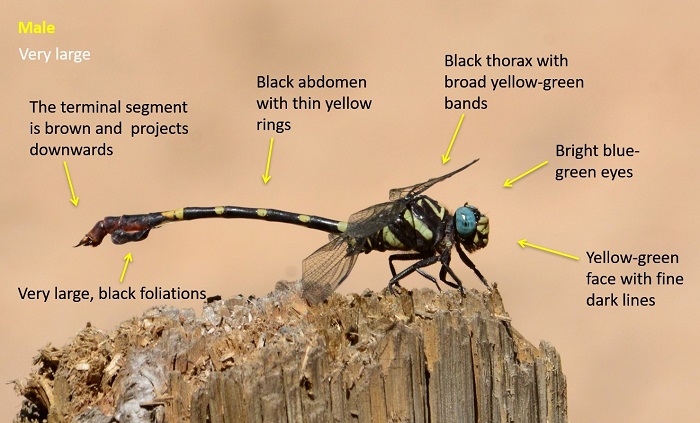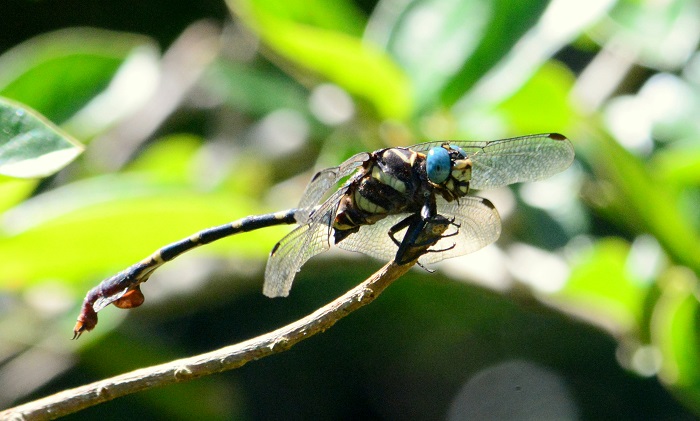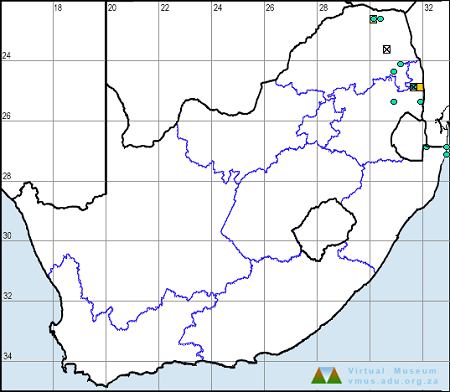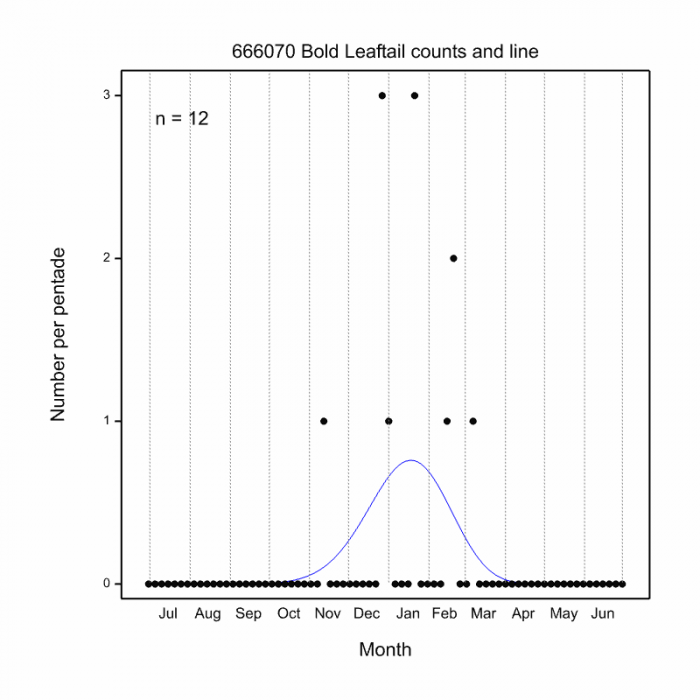Cover photo by Ronelle White.
Find the Bold Leaftail in the FBIS database (Freshwater Biodiversity Information System) here.
Family Gomphidae
Identification

Kosi Bay, KwaZulu-Natal
Photo by Ryan Tippett
Very Large
Length attains 70mm; Wingspan reaches 95mm.
The Bold Leaftail is an impressive and distinctive species. It may be confused with the slightly larger Ictinogomphus ferox (Common Tigertail), but that species is paler and appears yellow with black markings while Phyllogomphus selysi appears black-brown with yellow markings.
The Bold Leaftail may also be mistaken for Neurogomphus zambeziensis (Zambezi siphontail), but that species is decidedly smaller and paler with less conspicuous foliations on the abdomen.
Female Bold Leaftails resemble the males but are more robust and have smaller foliations on the tail, which may sometimes be absent.
Click here for more details on identification of the Bold Leaftail.

Siyadla River, KwaZulu-Natal
Photo by Ryan Tippett
Habitat
The Bold Leaftail inhabits hot savanna and forest regions where it occupies the wooded or forested fringes of rivers and streams. They appear to prefer open clearings with bushes near slow moving sections of rivers.

Kosi Bay, KwaZulu-Natal
Photo by Ryan Tippett
Behaviour
The Bold leaftail hunts from a perch and has a swift, powerful flight. They mostly perch on exposed twigs and branches on top of bushes, usually within two meters of the ground. Adults spend relatively little time at water and are more often found away from the river. Individuals are known to rest in the tree-tops when not hunting. The Bold Leaftail can be fairly confiding but remains alert, and will fly high and far once disturbed. Phyllogomphus selysi is elusive and seldom seen, and may be largely crepuscular in its activity.

Near Tshipise, Limpopo
Photo by John Wilkinson
Status and Conservation
The Bold Leaftail is a rare and localised species in South Africa. Phyllogomphus selysi reaches its southern limit in north-eastern South Africa where it is marginal and known from relatively few sites. It is listed as of Least Concern in the IUCN Red List of Threatened species. This is due to its wide distribution in tropical Africa. The Bold Leaftail is mostly found in undisturbed habitats.

Siyadla River, KwaZulu-Natal
Photo by Ryan Tippett
Distribution
Phyllogomphus selysi is a tropical species found in Central, Eastern and Southern Africa. Occuring from Cameroon across to Kenya and down through central Africa to Botswana, Zimbabwe, Mozambique, and South Africa. Its distribution in South Africa is limited to the Limpopo and Mpumalanga lowveld areas and extreme NE KwaZulu-Natal.
Below is a map showing the distribution of records for Bold Leaftail in the OdonataMAP database as at February 2020.

Below is a map showing the distribution of records for Bold Leaftail in the OdonataMAP database as at December 2024.

The next map below is an imputed map, produced by an interpolation algorithm, which attempts to generate a full distribution map from the partial information in the map above. This map will be improved by the submission of records to the OdonataMAP section of the Virtual Museum.


Ultimately, we will produce a series of maps for all the odonata species in the region. The current algorithm is a new algorithm. The objective is mainly to produce “smoothed” maps that could go into a field guide for odonata. This basic version of the algorithm (as mapped above) does not make use of “explanatory variables” (e.g. altitude, terrain roughness, presence of freshwater — we will be producing maps that take these variables into account soon). Currently, it only makes use of the OdonataMAP records for the species being mapped, as well as all the other records of all other species. The basic maps are “optimistic” and will generally show ranges to be larger than what they probably are.
These maps use the data in the OdonataMAP section of the Virtual Museum, and also the database assembled by the previous JRS funded project, which was led by Professor Michael Samways and Dr KD Dijkstra.
Phenology



Near Tshipise, Limpopo
Photo by John Wilkinson
Further Resources
The use of photographs by John Wilkinson and Ronelle White is acknowledged. Other photographs by Ryan Tippett.
Bold Leaftail Phyllogomphus selysi Schouteden, 1933
Other Common Names: Lowerstert (Afrikaans).
Recommended citation format: Loftie-Eaton M; Navarro R; Tippett RM; Underhill L. 2025. Bold Leaftail Phyllogomphus selysi. Biodiversity and Development Institute. Available online at https://thebdi.org/2020/05/25/bold-leaftail-phyllogomphus-selysi/
References: Tarboton, M; Tarboton, W. (2019). A Guide to the Dragonflies & Damselflies of South Africa. Struik Nature.
Samways, MJ. (2008). Dragonflies and Damselflies of South Africa. Pensoft
Samways, MJ. (2016). Manual of Freshwater Assessment for South Africa: Dragonfly Biotic Index. Suricata 2. South African National Biodiversity Institute, Pretoria
Martens, A; Suhling, F. (2007). Dragonflies and Damselflies of Namibia. Gamsberg Macmillan.

